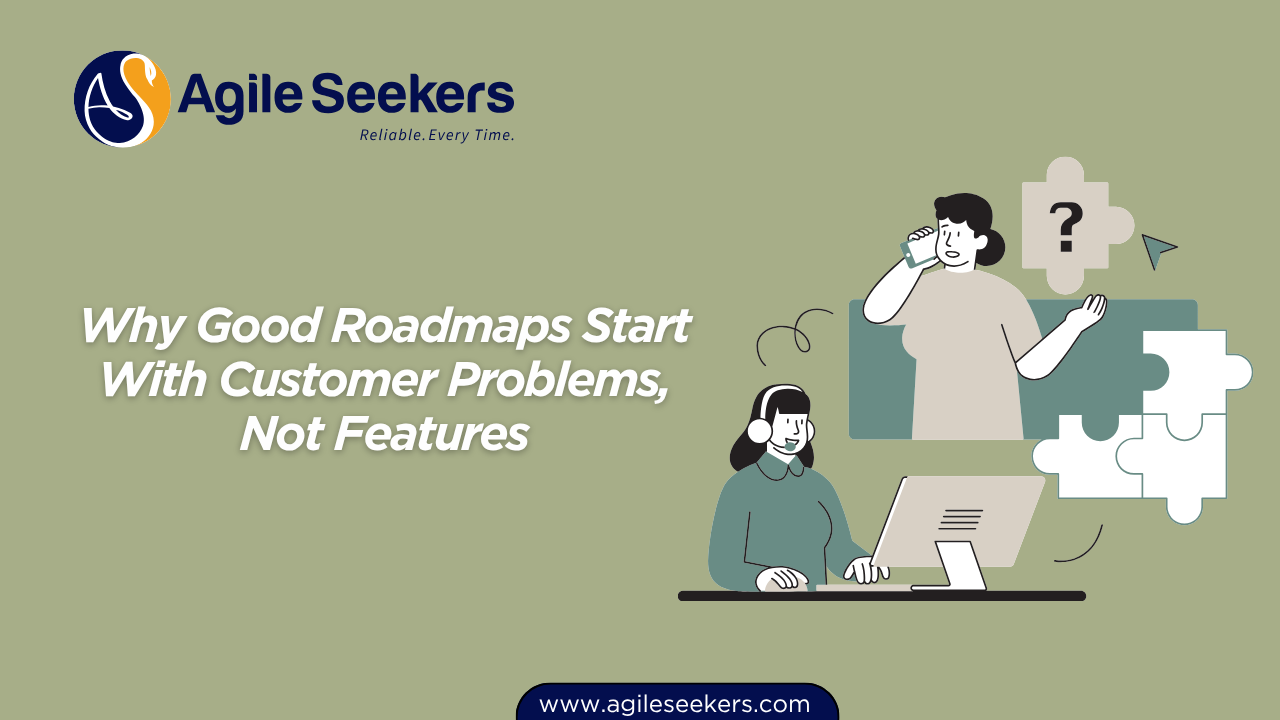Why Good Roadmaps Start With Customer Problems, Not Features

Most product teams feel the pressure to fill a roadmap with shiny features. It feels productive and looks impressive, but features alone don’t guarantee progress. Real progress comes from reducing customer pain, strengthening outcomes, and solving problems that matter.
When a roadmap starts with customer problems, not features, everything changes. Prioritization becomes clearer, decisions feel grounded, and teams align around evidence instead of opinions. Customers actually feel the value you deliver.
Features Don’t Guarantee Value — Problems Do
A feature is just one way to solve something. It’s an output. A problem describes a real situation customers struggle with. Teams that anchor roadmaps around problems:
- Stop shipping work no one asked for
- Avoid cluttering the product with low-impact functionality
- Focus on learning instead of jumping to conclusions
- Uncover better solutions than their first idea
This mindset echoes the customer-centric approach found in the Leading SAFe Agilist Certification Training, where value begins with understanding customer needs.
Why Teams Default to Feature-First Thinking
Most teams don’t start with customer problems because the alternative feels slower or less concrete. A feature is something you can point at, while a problem feels messy. But there are deeper reasons:
1. Feature Requests Feel Like Clarity
Stakeholders push for features because they believe they already know the answer. Statements like “add a dashboard” or “create a filter” sound specific but often miss the underlying need.
2. Metrics Reward Output, Not Outcomes
If teams are judged by velocity or delivery volume, they’ll naturally lean toward features instead of value.
3. Problem Discovery Takes Emotional Maturity
It takes curiosity and patience to dig deeper into customer pain and accept that initial assumptions may be wrong.
4. Solutioning Is Addictive
Brainstorming features is exciting, but it creates tunnel vision. Teams overlook alternatives that deliver better value with less effort.
This is why the SAFe POPM Certification Program emphasizes outcome-driven thinking and customer value alignment.
What Problem-First Roadmaps Actually Look Like
A problem-first roadmap doesn’t start with “Build feature X.” It starts with understanding customer struggles:
- Customers can’t complete tasks without switching between tools
- Users can’t track progress easily and raise repeated support tickets
- Teams lose time due to unclear handoffs
- New users get confused during onboarding
- Enterprise buyers struggle to see measurable ROI
These problems become themes. Solutions come later, once the team has explored and validated options.
Customer Problems Reduce Noise in Prioritization
Pushing features into a roadmap creates noise and invites opinions. Prioritizing problems shifts the conversation toward evidence.
1. Easier Comparison of Value
Teams ask questions like: Which problem is most costly? Which one blocks adoption?
2. Better Decision-Making
With clear problems, decisions rely on research and impact instead of influence.
3. Fewer Vanity Features
If a feature doesn’t solve a meaningful problem, it naturally drops away.
The SAFe Scrum Master Certification reinforces this clarity during Sprint Planning and team alignment.
Why Problem-First Roadmaps Align Stakeholders Better
Each department sees the world through its priorities. A problem-first roadmap pulls everyone into a shared reality:
- The real struggles customers face
- How serious those struggles are
- What solving them unlocks for the business
This reduces conflict and creates a shared narrative. It’s the style of alignment supported by the SAFe Release Train Engineer Certification, where problem clarity drives ART coordination.
Problem-First Thinking Enables Better Experimentation
When teams fixate on a feature, they stop exploring. When they anchor on problems, they open up options.
Instead of building “advanced reporting,” a problem-first approach asks what customers struggle with and explores alternatives like simple insight panels or quick exports.
The SAFe Advanced Scrum Master Certification teaches leaders to guide this kind of solution discovery.
Problem-First Roadmaps Reduce Rework
Most rework comes from solving the wrong thing. When teams understand root causes, they avoid wasted effort, last-minute changes, and features nobody adopts.
Even at the Scrum-team level, clarity like this is emphasized in the SAFe Scrum Master Training Program.
How to Build a Problem-First Roadmap
Step 1: Collect Real Customer Problems
Use interviews, support tickets, usage data, sales calls, and observed behavior to identify repeated patterns.
Step 2: Group the Problems Into Themes
Cluster them into areas like onboarding friction, missing visibility, workflow gaps, or decision bottlenecks.
Step 3: Understand the Root Causes
Look beyond symptoms to find where users hesitate or get stuck.
Step 4: Prioritize Based on Impact
Ask how many users it affects, how severe the cost is, and how it influences adoption or retention.
Step 5: Explore Multiple Solutions
Don’t lock onto one feature idea. Encourage discovery and experimentation.
Step 6: Add Solution Options to the Roadmap
Your roadmap becomes a combination of problems, hypotheses, potential solutions, and success measures.
How This Strengthens Agile Delivery
A roadmap grounded in customer problems improves planning, estimation, collaboration, and iteration. PI Planning becomes more coherent, and teams stay focused on value instead of output.
This approach aligns well with practices from the Leading SAFe Agilist Certification Program and the SAFe POPM Certification, both of which place customer value at the center.
External Inspiration
- Jobs to Be Done theory
- Lean UX and hypothesis-led development
- Opportunity Solution Tree by Teresa Torres
- Basecamp’s Shape Up methodology
All of these highlight the same principle: focus on customer struggles before thinking about features.
The Real Win: Strategic Roadmaps
A feature-first roadmap is a to-do list. A problem-first roadmap is a strategy. One tells the team what to build; the other tells the team why it matters.
When teams align on customer problems, prioritization sharpens, decisions become rational, and customers feel the impact. Roadmaps stop being presentations and start becoming living guides for value creation.
The shift is simple: don’t ask “What should we build next?” Ask “Which customer problem deserves our energy next?”
Also read - How to Build a Roadmap That Balances Ambition With Reality
Also see - The Role of Data in Creating Confident Product Roadmaps




















